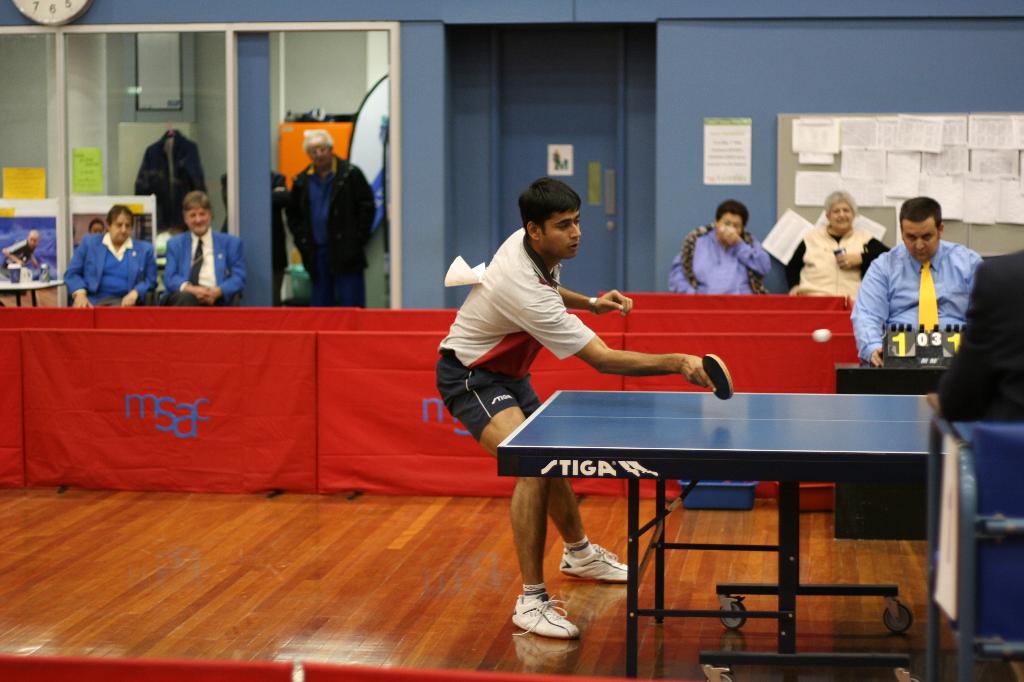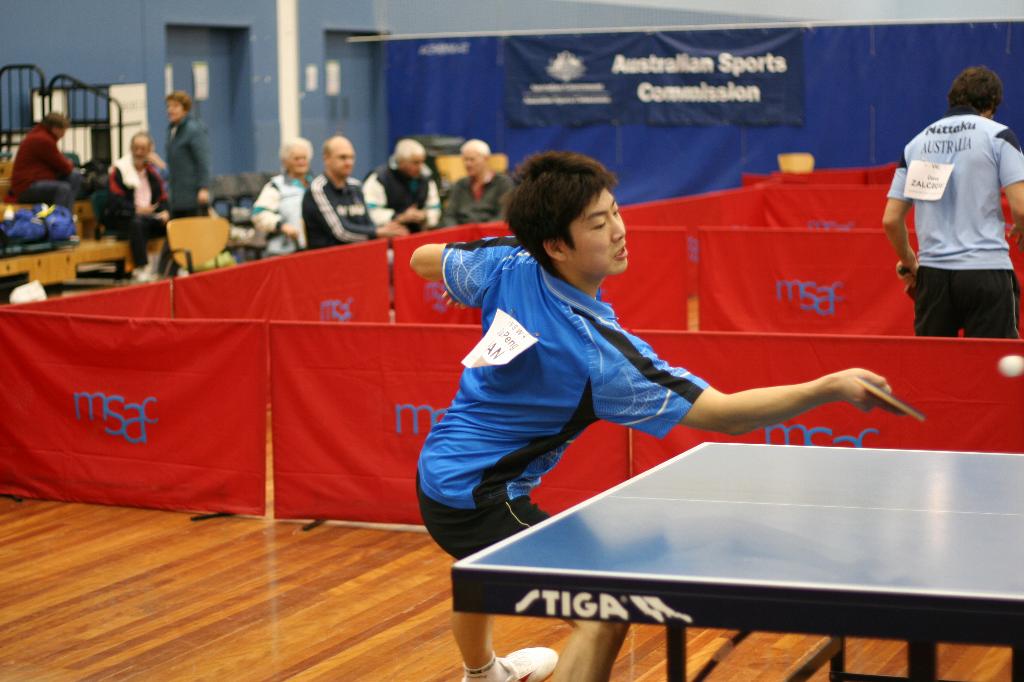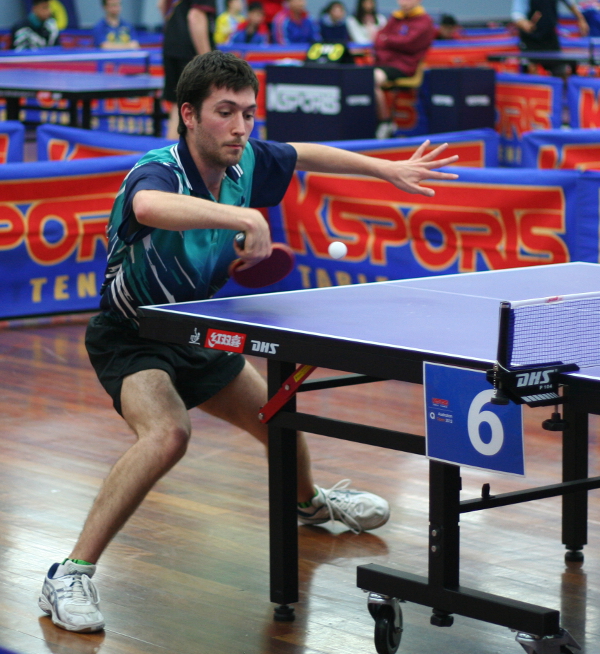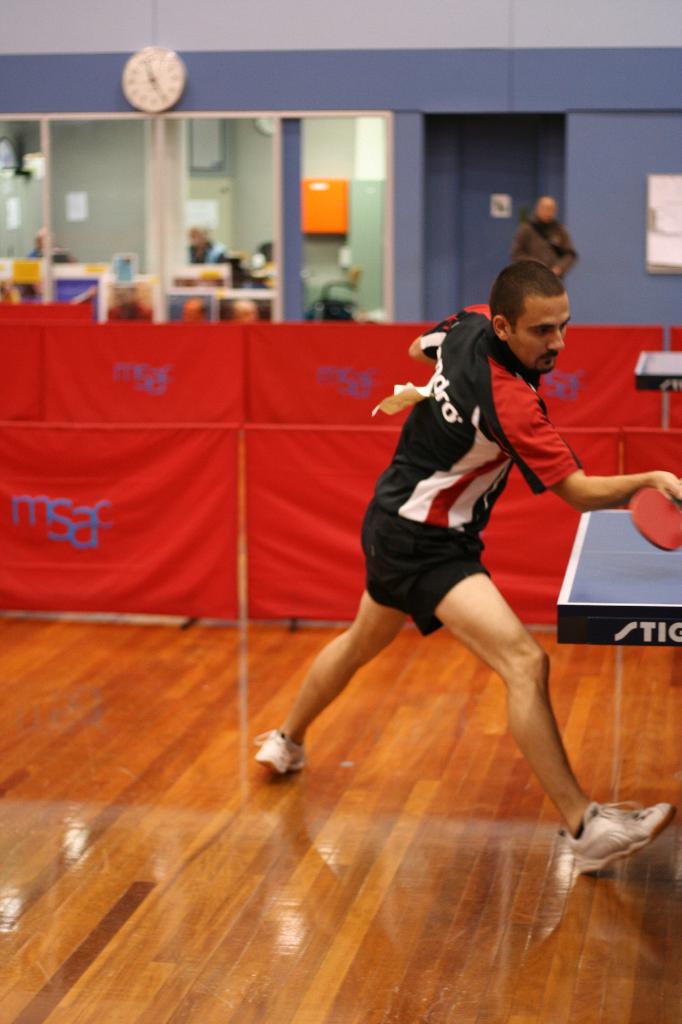
I have already talked about the importance of the service in table tennis. Now that you fully appreciate why serving is so important, it’s time to look at the flip side of the coin (or bat!), and discuss the return of serve.
Ask any beginner who has been playing a while why he is having trouble winning games, and a common excuse will be the difficulty of returning serve. You’ll hear this put in a variety of ways – from blaming the opponent (“I could beat so-and-so if he didn’t have those tricky serves”), to blaming the equipment (“The table/ball is bouncing funny”), but you will rarely hear someone say that it because their own return of serve is bad! Don’t fall into this trap – if your opponent is serving legally and you are having trouble returning the ball – it’s not him, it’s you!
For beginners, the return of service is very probably the most important stroke in the game. Even at high levels the return of serve is a very important stroke, and is trained accordingly.
As with the service, it is possible to break up this discussion of the service return into four topics:
- Why is the Return of Serve Important in Table Tennis?
- How to Improve Your Return of Serve – Theoretical Advice
- How to Improve Your Return of Serve – Practical Advice
- How to Troubleshoot Your Return of Serve
Why Is The Return Of Serve Important In Table Tennis?
Since I spent quite a bit of time explaining why the serve is important, you might well be thinking that getting the serve back must be important too. And you’d be right!
Listed below are the main reasons why the return of serve is so important in table tennis today:
- As we discussed previously, the serve is used by smart opponents to help set up their attacks. Good returns of serve can neutralize the server’s advantage and put the receiver into the rally on equal terms.
- Very good returns of serve can actually take the initiative from the server, and allow the receiver to get his own attack started first, forcing the rally to develop along the receiver’s own favorite type of play.
- If you can’t return serve well, you won’t be able to use your rallying skills at their best. You will always be on the defensive when you are the receiver, since the server will be able to dominate the game with a good serve and powerful follow up attack. Remember that you will have to return serve on 50% of all points in singles – there’s no way to avoid it!
- As one of the most difficult aspects of table tennis to master, the serve return also has the greatest potential for improving your game. The return of serve is often the most neglected aspect of the beginner and intermediate player’s game (advanced players have usually learnt better from bitter experience). With a little work you can soon have a better return of serve than most of your competition (since they are generally not practicing their return of serve at all), which is a handy edge to have.
- Having a good return of serve can increase the pressure on your opponent, since he knows that he must serve well to prevent you from attacking him. It is very difficult to serve well when you are tense from knowing that anything less than a good serve will be attacked ruthlessly by your opponent!
How To Improve Your Return Of Serve – Theoretical Advice

Now that you can see why returning serve well is vital to playing good table tennis, let’s talk about what you need to know in order to have the best chance of having a good return of serve.
- Be aggressive when returning serve. Try to attack whenever you can, and if you can’t, try to return so that the server can’t attack well. The mental checklist shown in point two below gives the stroke priority in which you should be trying to return serve. Don’t think that you have to ask yourself every question in reality – there isn’t enough time. But with practice your decision making will speed up and your choices will improve, even if you aren’t consciously making these decisions.
- Is the ball going to bounce off the end of the table? If YES then attack the ball.
Is the ball going to bounce high? If YES then attack the ball with a well placed flick.
Is the ball going to bounce near the net? If YES you can use a short push or float return to make a double bounce return that is difficult to attack.
Does the ball have medium to heavy backspin? If YES, push the ball fast and deep. If NO, you can push or flick the ball to make a return that is difficult to attack well.
Note: Players who possess a good banana flick can almost ignore the above checklist, and just about simplify the decisions to –- If it is long, loop it.
- If it is going to double bounce wide to your forehand, push or flick with the forehand.
- Everything else, banana flick it.
- When returning serve, be aggressive in proportion to the quality of the serve. Good serves should be handled with care, and placement used instead of power. Average serves can be attacked with good spin and some speed. Weak serves should be attacked strongly with power and some spin. Many beginners lose too many points by trying to attack an average serve with too much power, and end up hitting the net or missing the end of the table. Don’t give your opponent any freebies.
- You must be watching like a hawk at the time the server actually hits the ball. Seeing the moment of contact is what will give you the best chance of deciphering what spin, speed and placement is on the ball. Without seeing the contact you are stuck with making guesses, and the chances are good that you are going to be wrong.
- At the time of contact, note the direction that the server’s bat is moving. If it is moving to your left, the ball will jump off your own bat towards the left side of the table, and vice versa if his bat is moving to the right. If his bat is moving under the ball (or down the back of the ball), there will be backspin, and if it is moving over the ball (or up the back of the ball), there will be topspin. Remember that most serves have a combination of sidespin and either backspin or topspin.
- For topspin and backspin, it is easiest to return like with like. Return topspin with topspin, and backspin with backspin. Your spin and your opponent’s spin will tend to cancel each other out, allowing easier control of the ball. Don’t be afraid to try it the other way around though for variation, since using backspin against topspin and topspin against backspin can be very effective, although a little more difficult to do.
- For sidespin, working with the spin is easiest. For example, if the server’s bat is moving to your right at contact, put your bat a little to the right of the ball and hit the ball a little on its right hand side, aiming towards the left side of the table. This will keep a lot of your opponent’s sidespin on the ball, and he will have to deal with it on his next stroke.
- Working against the spin for sidespin serves is an advanced tactic that is recommended for advanced players only. Although very effective it requires a lot of control and touch to perform well.
- It is easiest to always use a little spin at least to improve your ball control. Returning serves using float balls requires very good timing and touch, and an exact reading of the spin, which is difficult. Using a small amount of spin will allow you to be slightly incorrect and still make a good stroke.
- Most of the time it is easiest to hit the ball at the peak of its bounce. Do not be afraid to change your timing every so often to increase the amount of variation the server has to cope with.
- When placing the ball, you should stick to a few simple rules. Making the server move to hit the return is always a good idea. Placing the ball into the playing elbow is also a very good tactic if you can hit it with a little bit of speed, but your target is not that big, so be careful of trying this too often. If you keep making mistakes with the placement use the wide angles more often.
- Some beginners get carried away with flicking, and try to flick every short serve. Don’t overdo it – serves with heavy backspin are difficult for beginners to flick well, and a flick that is badly placed is an easy ball for a server to attack, since flicks don’t have much topspin. Again, the fast push can be used effectively to give you more variation, and give the server a harder ball to attack due to the backspin on the ball.
- Take note of what patterns and favorite shots your opponent uses, and try to return so that he can’t do these well or often. Instead, try to return so that you can play your own favorite shot or patterns.
- Remember that a smart opponent will adjust very quickly if you always use the same return against a particular service. Use your best return the most often, but also use different types of strokes, spin, speed and placement so that your opponent finds it harder to get used to your returns.
How to Improve Your Return of Serve – Practical Advice

As I explained previously, the return of serve is very important, so you might well ask why is it so neglected? The main reason is probably because it helps to have another player to serve to you in order for you to practice your serve return. Funnily enough, most players aren’t willing to allow you to practice returning their best serves – most unfair! So here are some practical tips that will help you improve your return of service, both with and without a partner.
- Practice with a friend/training partner that wants to work on their serves and serve returns. Have them use serves that you are having trouble with – they get to practice their serve and you get to practice your returning. Then swap around and do some serves for them to practice returning.
- During a match, if a serve hits the net and comes over to your side, don’t catch it. Let it bounce and hit it back, noting the type of spin on the ball. It’s like a free preview of your opponent’s serve.
- Note that the ball generally bounces lower on service, since it is mainly contacted fairly close to net height. Make sure that you use your knees to get down to the ball when returning, instead of bending from the waist.
- A good way to practice telling the difference between long balls and short balls is to have a training partner serve the ball to you, and then play a shadow shot with your empty hand, deliberately missing the ball. Notice how often you would have pushed or flicked balls that were actually going off the end of the table and could be attacked with power instead.
- When you are not playing at a tournament, watch your opponent’s serves against other players, and try to pick what type of serve they are doing. This will help you get familiar with a particular player’s favorite serves.
- Put in the middle of the server’s side of the table table a folded towel, or even better a piece of string with blu-tack or low-adhesive sticky tape on the corners to form a square about 15-20 inches wide. Have your training partner serve the ball, and when you return the service try to keep your return out of the square. You should be able to notice that the more often you keep your return out of the square, the harder it is for your training partner to attack strongly.
- A robot can be handy for learning to deal with different types of spins. The nice thing with robots is that the spin and speed can be set to the same amount over and and over again, until you get master your return technique. A human server will always have some variations in his serve, and may well lose patience with serving the same serve to you over and over again! The downside with a robot is that you do not get to practice watching the service motion.
- If you are having problems finding a training partner willing to serve to you, why not pay a coach or advanced player to give you some serving practice? You’ll probably get some good tips as well – well worth the money!
- If you do training drills, start more of the drills with a proper serve and serve return, rather than the standard easy topspin serve. This can easily increase the amount of serve return practice you get, without taking up any more time.
- If you are having problems returning a particular serve, try to master the serve yourself. Once you understand all about that serve, you will find it much easier to pick when your opponent is using it on you!
- From time to time, try using one type of return against every serve. You will make a few mistakes, but you will also find that you will succeed in returning serves that you would not normally have even tried to return with that type of stroke. This method is a very good way of finding out exactly what you can and can’t do with a particular type of return – you may be better than you think!
How to Troubleshoot Your Return of Serve
Just as there are times when you will not be serving well, there will also be times when you are having problems with returning serve. Actually, there will probably be more times when you are struggling with your serve return, since when you are serving you have total control of the ball, and when you are receiving serve your opponent is trying to make your life more difficult!

Here are some ready to go tips for when you need to fix your return of serve fast.
- When you are in doubt about the amount of spin on the ball, spin it yourself a little more, not less. The natural reaction when you are unsure of the spin is to gently touch the ball, attempting to caress it back. Unfortunately this does not work well with modern rubbers and their intense reaction to spin. So when in doubt, use a heavy spin – it will increase your chances of overpowering whatever spin your opponent has placed on the ball. Don’t hit it faster, just spin it more.
- When you are having trouble attacking the serve, and being forced to push when receiving, a double bounce push is the best return, provided you can keep it low. It is also the most difficult return to make. I would recommend to keep practicing this stroke but only start using it in games when you can do it successfully at least 70% of the time. Until then stick to using a fast deep or fast angled push, which is a little less effective but much easier for you to do successfully.
- When your opponent is attacking your returns too easily. When you are learning to return serve, the middle of the table is the safest place to aim at to allow for errors. As your control improves, you must begin to keep away from the middle of the table when returning serve. You want to either make your opponent move sideways to reach the ball, or aim at his playing elbow so that he has to decide whether to hit it with his forehand or backhand, and then has to move to play the stroke as well.
- If you are having trouble reading the spin, make sure you are watching closely at the time of contact. Also try to watch your opponent serve against other players, and try to guess what spin he is putting on the ball. With a little close observation you’ll soon start to recognize his different serves.
- When you are having trouble with a particular serve, master the serve yourself – not only will this give you another serve to add to your own arsenal, but it will help you understand and return that type of serve more easily. Watch better players return that serve – see what they do, think about why they are playing that stroke, note how effective it is, and decide whether that type of return would suit your style of play. If so, then try it out!
- If you are making too many mistakes when attacking the serve, you should try to be as aggressive as you can be while maintaining some margin for error. If you are attacking but hitting too many serves into the net or off the end of the table, reduce your power a little, and increase your spin. This will give you more height over the net, and a ball that drops a little shorter on the table with good spin. When your opponent blocks the ball back, you can hit his return with more power.
- If you find that you are still making too many mistakes when attacking the serve, you can try using a push or chop instead. Get the ball back into play a few times, and make your opponent work for the point. Don’t just keep hitting and missing if you can’t get the ball on – your opponent may just have too good a serve for you to attack, and you can’t afford to keep giving him freebies. Then make sure you do some more practice against that type of serve in training later on.

